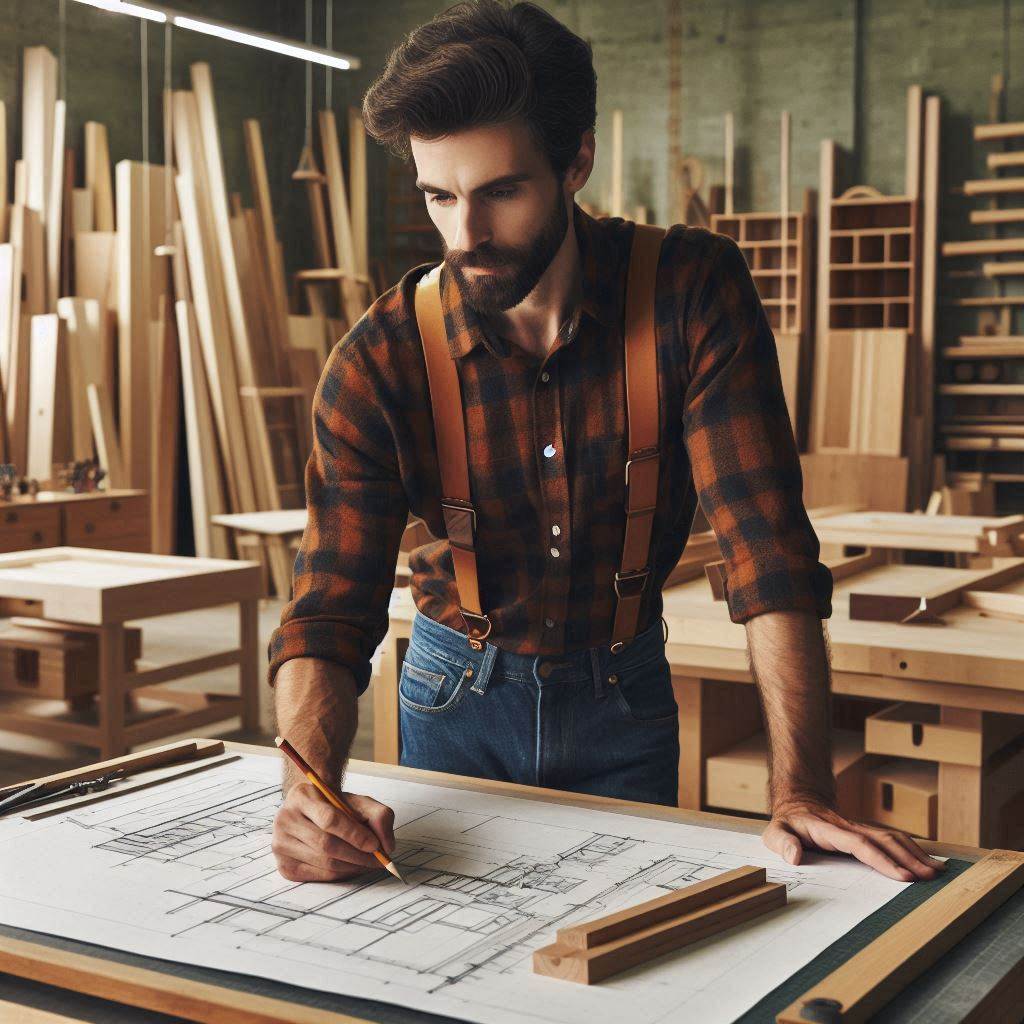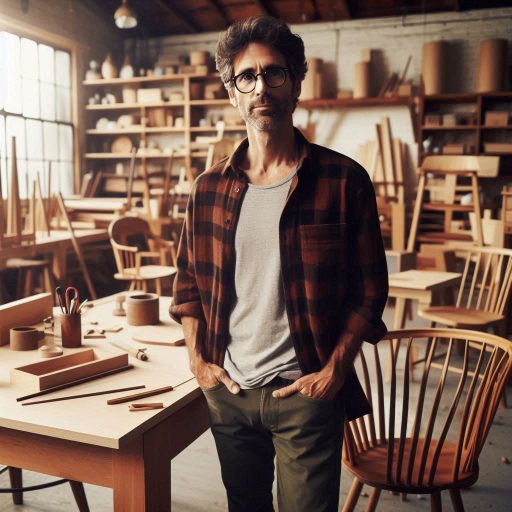Introduction
A furniture designer creates functional and aesthetically pleasing furniture pieces that enhance spaces.
They blend art and engineering to develop items for homes, offices, and commercial environments.
This profession requires a unique set of skills, including drawing, computer-aided design (CAD), and a thorough understanding of materials and production processes.
Critical skills also include problem-solving and project management.
Furniture designers must communicate effectively with clients, manufacturers, and suppliers to bring their visions to life.
Creativity plays a vital role in furniture design.
Designers envision unique concepts that stand out in a crowded market.
They draw inspiration from various sources, such as art, architecture, and nature.
Innovation drives the industry forward, introducing new materials and techniques that redefine furniture aesthetics and functionality.
Sustainable design is increasingly important in today‘s world.
Eco-friendly solutions attract modern consumers who prioritize sustainability.
A successful furniture designer stays adaptable, continually refining their craft and pushing boundaries.
They embrace feedback and are willing to iterate on their designs.
Networking with other professionals in the industry can also open doors to new opportunities and collaborations.
Ultimately, the journey of a furniture designer involves a commitment to creativity, innovation, and ongoing growth.
Education and Training
Different educational paths to becoming a furniture designer
Becoming a successful furniture designer requires a solid educational foundation.
Many aspiring designers pursue formal education in furniture design, industrial design, or interior design.
Degree programs provide essential skills and knowledge.
Students learn about materials, ergonomics, and design principles.
They also gain experience with design software, which is crucial in today‘s market.
Formal education offers structured learning environments.
Students receive guidance from experienced instructors and access to valuable resources.
They can participate in workshops and collaborative projects.
These opportunities foster creativity and innovation.
Alternatively, apprenticeships provide practical, hands-on experience.
Many successful designers start their careers by working under established professionals.
This mentorship allows them to learn directly from industry veterans.
Apprenticeships can lead to job opportunities in design firms or manufacturing companies.
Internships play a vital role in the education of furniture designers.
These experiences help students apply theoretical knowledge in real-world settings.
Interns work on actual projects, enhancing their skills and building portfolios.
They also develop a network of industry contacts, which can be invaluable for future job searches.
The benefits of gaining hands-on experience through internships or working
Working in a furniture design studio offers additional benefits.
Designers gain insight into daily operations and project workflows.
They learn how to collaborate with other professionals, such as carpenters and upholsterers.
This collaboration fosters teamwork skills, essential for successful design projects.
Hands-on experience is crucial for understanding materials and construction techniques.
Designers who work with their hands develop a better appreciation for quality craftsmanship.
They also learn how to troubleshoot problems during the design and manufacturing processes.
Additionally, many furniture designers benefit from workshops and continuing education courses.
These opportunities help them stay current with trends and technologies.
Designers can explore new materials, sustainable practices, and innovative design techniques.
Lifelong learning is key in this ever-evolving field.
Networking with peers and industry professionals enhances education and training.
Attending design expos, conferences, and workshops exposes designers to fresh ideas.
They can gather inspiration and gain insights from others in the field.
Building relationships within the industry can open doors to new opportunities.
Aspiring furniture designers should explore various educational paths.
Formal education, apprenticeships, and internships all offer unique benefits.
Gaining hands-on experience is essential for developing practical skills.
Continuous learning and networking will help designers stay relevant.
By investing in education and training, designers can set themselves up for success in the furniture design industry.
Read: Historic Costume Design Inspirations
Building a Portfolio
A strong portfolio is crucial for aspiring furniture designers.
It showcases your skills, creativity, and unique design perspective.
Here are the key elements of a strong portfolio and tips on showcasing a variety of design styles and materials.
Key Elements of a Strong Portfolio
- Diverse Design Examples: Include a range of your best work.
Show different types of furniture, such as chairs, tables, and storage units.
Highlight your versatility and ability to work on varied projects. - Concept Development: Showcase your design process, from initial sketches to final products.
Include mood boards, inspirations, and rough sketches to demonstrate your creative journey and thought process. - Technical Drawings: Add detailed technical drawings to display your understanding of furniture construction.
These can include dimensions, material specifications, and assembly details.
They show you know how to translate ideas into functional designs. - High-Quality Photographs: Use professional, high-resolution images to capture your designs.
Include shots from multiple angles to highlight design details, finishes, and craftsmanship. - Material Variety: Display your ability to work with various materials like wood, metal, glass, and upholstery.
Showcasing your knowledge of different materials demonstrates your adaptability as a designer. - Digital Skills: Highlight your proficiency in design software such as AutoCAD, SketchUp, or Rhino.
Include renders and 3D models to emphasize your technical skills and ability to create realistic visualizations. - Client or Project Briefs: If applicable, include brief descriptions of client projects or design challenges.
Describe the requirements and how your design met the goals, showcasing problem-solving abilities.
Tips for Showcasing a Variety of Design Styles and Materials
- Balance Between Styles: Incorporate various styles, from modern and minimalist to traditional and eclectic.
This will display your versatility and ability to cater to different tastes. - Experiment with Materials: Use different materials and finishes in your designs. Show combinations like wood with metal or fabric with glass.
It demonstrates your creativity and broad material knowledge. - Keep It Updated: Regularly update your portfolio with new designs.
Keeping it fresh shows your growth as a designer and keeps your work relevant. - Create a Digital Portfolio: Make your portfolio easily accessible with a professional website.
This allows potential clients to view your work anytime, increasing your exposure.
A well-crafted portfolio will set you apart in the competitive field of furniture design.
Focus on quality, diversity, and presentation to make a lasting impression.
Read: Freelance vs. In-House Costume Design Jobs
Networking and Building Relationships
Networking is crucial in the furniture design industry.
It opens doors to new opportunities, collaborations, and clients.
Successful furniture designers leverage their networks to stay updated on industry trends, gain inspiration, and find potential business partners.
Importance of Networking in Furniture Design
- Access to Opportunities: Networking helps designers discover job openings, freelance gigs, and collaboration projects with manufacturers.
- Building Brand Recognition: A strong network boosts your visibility, making you a known entity in the design community.
- Learning and Inspiration: Engaging with other designers provides fresh perspectives, inspiration, and new design techniques.
- Staying Ahead of Trends: Networking keeps you informed about the latest trends, materials, and technologies in the furniture design world.
Strategies for Connecting with Industry Professionals
Building strong relationships requires consistent effort and strategic approaches.
Here are effective ways to connect with potential clients, manufacturers, and other designers:
Attend Industry Events and Trade Shows
- Attend trade shows like Salone del Mobile and ICFF to meet industry leaders.
- Participate in workshops and panel discussions to showcase your knowledge and skills.
- Exchange contact details and follow up with meaningful conversations post-event.
Leverage Social Media Platforms
- Use Instagram and Pinterest to showcase your portfolio and attract potential clients.
- Connect with fellow designers on LinkedIn to expand your professional network.
- Engage in design-related groups and forums to stay active in the community.
Join Design Associations and Networks
- Become a member of associations like the American Society of Furniture Designers (ASFD).
- Participate in local design meetups and networking events organized by these associations.
- Use association resources to connect with manufacturers and retailers.
Collaborate with Other Designers
- Partner with other designers on projects to expand your skills and reach new audiences.
- Share resources and contacts to build mutually beneficial relationships.
- Co-host design workshops or webinars to establish authority in the field.
Engage with Manufacturers and Suppliers
- Visit manufacturers and suppliers to understand their processes and materials.
- Build relationships with suppliers to access exclusive materials and preferred pricing.
- Regularly communicate your design needs and seek feedback to improve your product quality.
Offer Value to Potential Clients
- Offer free consultations or design insights to attract and engage potential clients.
- Create compelling presentations and proposals tailored to client needs.
- Maintain consistent communication and follow up on client feedback to build trust.
Networking is a powerful tool for furniture designers.
By actively connecting with industry professionals, designers can enhance their skills, gain new clients, and stay competitive.
Embrace every opportunity to network, whether online or in person, and watch your furniture design career thrive.
Staying Current with Trends
Staying up-to-date with industry trends and emerging technologies is crucial for any furniture designer.
Trends constantly evolve, impacting consumer preferences, material choices, and design techniques.
To remain competitive, designers must actively seek inspiration and stay informed about the latest developments.
Importance of Staying Up-to-Date
- Enhance Creativity: Staying current helps spark new ideas and influences your creative direction.
It ensures your designs feel fresh and relevant. - Meet Market Demands: Understanding trends allows you to anticipate what customers want.
This knowledge helps you create designs that resonate with consumers. - Adopt Emerging Technologies: Technology continues to shape furniture design, from 3D printing to sustainable materials.
Keeping pace with these innovations can enhance your design process. - Build Your Brand: Incorporating the latest trends into your work positions you as a forward-thinking designer.
This can attract clients who are looking for cutting-edge designs. - Stay Competitive: Designers who ignore trends risk falling behind.
Staying informed ensures you keep your skills sharp and relevant in a crowded market.
Resources for Finding Inspiration
Finding reliable sources to track trends is essential.
Here are some ways to keep your design skills up-to-date:
Follow Design Blogs and Magazines
- Dezeen: A top source for design and architecture trends.
- Architectural Digest: Offers insights into interior and furniture design trends.
- Furniture Today: Focuses on the business side of furniture design and market shifts.
Attend Design Fairs and Exhibitions
- Salone del Mobile: One of the largest and most influential furniture fairs globally.
- ICFF (International Contemporary Furniture Fair): Showcases innovative designs from emerging and established designers.
- Milan Design Week: Offers a glimpse into the future of furniture design, with displays from top brands.
Leverage Online Learning Platforms
- MasterClass: Learn from renowned designers on how to stay creative and trend focused.
- Skillshare: Offers courses on furniture design, including trend analysis and material innovation.
- Coursera: Provides insights into design thinking and the impact of new technologies.
Network with Other Designers
- Join professional groups like the American Society of Furniture Designers (ASFD).
- Attend industry webinars to connect with like-minded professionals and share insights.
Staying current with trends and technologies keeps you at the forefront of the furniture design industry.
Embrace continuous learning, engage with the community, and seek out inspiration to fuel your creative journey.
Read: Networking Events for Costume Designers

Marketing and Promoting Your Work
As a furniture designer, establishing a strong personal brand is essential for success.
Your brand reflects your style, values, and approach to design.
Here‘s how to create a compelling personal brand and effectively market your work.
Creating Your Personal Brand
- Define Your Style: Identify your unique design aesthetic.
Consider what materials, colors, and shapes resonate with you. - Craft a Mission Statement: Summarize your design philosophy and goals.
This statement should communicate your vision to potential clients. - Develop a Logo: Design a memorable logo that reflects your style.
Ensure it‘s versatile for various applications, from business cards to online platforms. - Build a Professional Website: Create an online portfolio showcasing your work.
Include high-quality images and detailed descriptions of each piece. - Use Consistent Branding: Maintain consistent branding across all platforms.
Use the same colors, fonts, and tone in your marketing materials.
Effective Marketing Strategies
Leverage Social Media
Social media platforms are powerful tools for reaching your audience.
Here‘s how to make the most of them:
- Choose the Right Platforms: Focus on platforms that suit your style.
Instagram and Pinterest are ideal for visual content. - Share High-Quality Content: Post images of your designs regularly.
Use professional photography to showcase your work effectively. - Engage with Your Audience: Respond to comments and messages promptly.
Build a community around your brand through active engagement. - Use Relevant Hashtags: Utilize hashtags to increase visibility.
Research popular tags in the furniture design community. - Collaborate with Influencers: Partner with influencers in the design space.
Their endorsement can expand your reach and credibility.
Participate in Industry Events
Attending industry events is a great way to network and promote your work.
Here‘s what to do:
- Join Trade Shows: Exhibit your designs at trade shows.
This exposure can attract potential clients and collaborators. - Attend Workshops and Seminars: Learn from industry experts.
These events provide valuable insights and networking opportunities. - Network with Other Designers: Build relationships with fellow designers.
Collaborations can lead to new opportunities and visibility. - Engage with Customers Directly: Use events to interact with potential customers.
Collect feedback and understand their preferences. - Follow Up After Events: Maintain connections made during events.
Send personalized messages or emails to nurture these relationships.
Marketing and promoting your work as a furniture designer requires a strategic approach.
By creating a strong personal brand and utilizing effective marketing strategies, you can significantly enhance your visibility.
Leverage social media and participate in industry events to build a network and showcase your designs.
Stay consistent, engage with your audience, and continually refine your brand for lasting success.
Read: Famous Costume Designers in Hollywood
You Might Also Like: Essential Tools and Software for Concept Artists
Transform Your Career Today
Unlock a personalized career strategy that drives real results. Get tailored advice and a roadmap designed just for you.
Start NowDealing with Challenges
Addressing Common Challenges
As a furniture designer, one of the most common challenges you may face is finding the right balance between your creative vision and the demands of your clients.
Clients often come to you with specific requests or expectations, which may sometimes conflict with your own artistic vision.
It can be challenging to navigate this delicate balance while still delivering high-quality designs that satisfy both parties.
Another challenge that furniture designers often encounter is the constant pressure to stay relevant and innovative in a highly competitive field.
With new trends constantly emerging and evolving, it can be difficult to keep up and continue to produce designs that resonate with consumers.
This pressure can sometimes lead to creative blocks or feelings of imposter syndrome, making it challenging to stay motivated and inspired.
Tips for Overcoming Obstacles
Despite the challenges that furniture designers may face, there are several strategies you can implement to overcome obstacles and stay motivated in your career.
- Set Clear Boundaries: Establishing clear boundaries with clients from the outset can help manage expectations and prevent potential conflicts down the line.
Communicate openly and transparently about your creative process and limitations to ensure that both parties are on the same page. - Stay True to Your Vision: While it’s important to listen to your clients’ needs, don’t compromise your artistic integrity.
Find ways to incorporate their feedback without sacrificing your unique style or creative vision.
Remember, clients seek out your expertise and vision for a reason. - Embrace Challenges as Opportunities: Instead of viewing challenges as roadblocks, see them as opportunities for growth and learning.
Use obstacles as a chance to push your creative boundaries, experiment with new techniques, and expand your skill set.
Embracing challenges can lead to personal and professional development. - Seek Inspiration: When facing creative blocks or feeling demotivated, seek inspiration from sources outside of your usual comfort zone.
Explore other forms of art, visit galleries, attend design workshops, or even take a break and travel to spark new ideas and perspectives.
Surrounding yourself with creativity can reignite your passion for design. - Build a Support Network: Surround yourself with peers, mentors, or fellow designers who understand the challenges of the industry.
Seek guidance, feedback, and support from others who can offer fresh perspectives and insights.
Collaborating with like-minded individuals can provide motivation and encouragement during tough times.
Furniture designers can tackle common challenges directly.
By implementing proactive strategies, they can overcome obstacles.
This approach helps them stay motivated and thrive in a competitive field.
Remember, resilience, creativity, and a passion for design are key ingredients for success in this dynamic industry.
Conclusion
Becoming a successful furniture designer requires dedication, creativity, and a willingness to learn.
Start by honing your design skills through formal education and practical experience.
Consider enrolling in design courses that cover essential topics like aesthetics, ergonomics, and material science.
Understanding these fundamentals is crucial for creating functional and beautiful pieces.
Building a strong portfolio is vital for attracting clients and showcasing your best work.
Include a variety of projects that highlight your versatility and unique style.
Attend design fairs, workshops, and exhibitions to connect with others and gain valuable insights.
Stay updated on design trends and innovations to remain competitive.
Follow influential designers and brands on social media, read industry publications, and engage in online forums.
This knowledge can inspire your work and help you identify market demands.
By following these steps, you can carve out a successful career as a furniture designer.
Your unique vision has the power to transform spaces and inspire others.
Keep creating and pushing the boundaries of your craft, and don‘t hesitate to seek feedback from peers and mentors.
The journey may be challenging, but your dedication will pave the way to success in furniture design.




